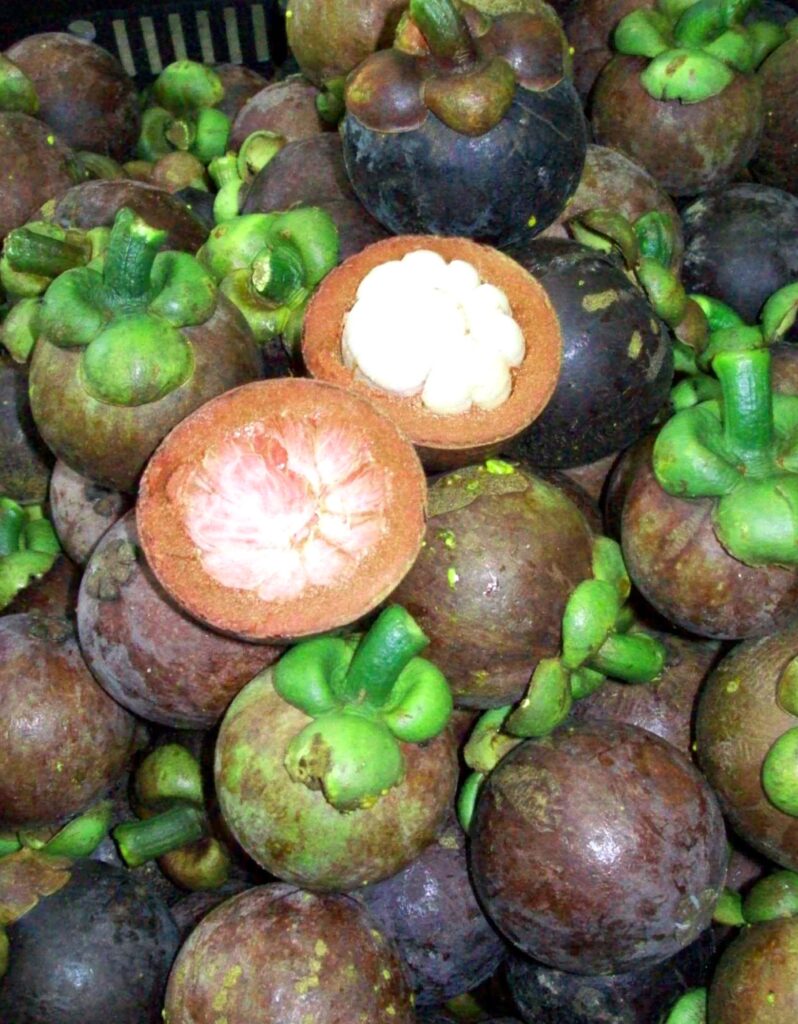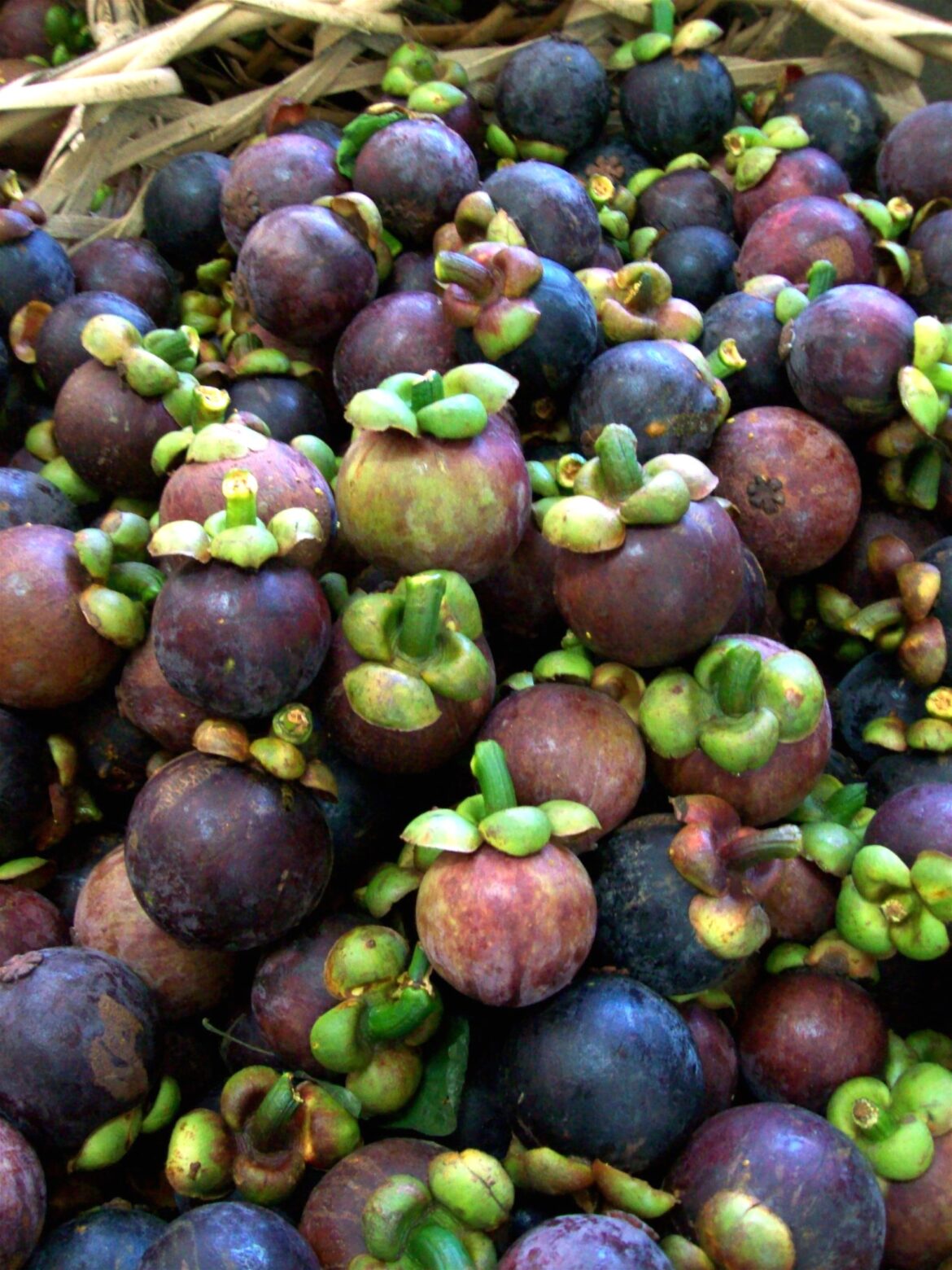Text and Photos by Henrylito D. Tacio
Mangosteen: The Queen of fruits. Among tropical fruits in Asia, mangosteen is considered the queen (durian is touted as the king). If the fruit were a movie personality, mangosteen would be Audrey Hepburn.
The mangosteen has a long and rich history in the region. Its place of origin is unknown but is believed to be the Sunda Islands and the Moluccas. A jungle evergreen that flourishes in Malaysia, Indonesia, Cambodia, Vietnam, Thailand, China, and the Philippines, this tree bears a remarkable fruit that is so indescribably delicious. European scientists, who came to the region, gave it a new name: Garcinia mangostana.
Speaking of names, there are various names to the fruit: among Spanish-speaking people, it is called mangostan; to the French, it is mangostanier, mangoustanier, mangouste or mangostier; in Portuguese, it is mangostao, mangosta, or mangusta; in Dutch, it is manggis or manggistan; in Vietnamese, mang cut; in Malaya, it may be referred to in any of these languages or by the local terms, mesetor, semetah, or sementah; in the Philippines, it is mangis or mangostan.
Today, in the often-chaotic market places of Southeast Asia, you can find this heavenly-flavored fruit. The fruit takes the form of a dark purple sphere with thick, waxy sepals surrounding a short length of stem on top. The bottom of the fruit bears a flat, raised, asterisk-like ornament. The number of points on this little star indicates the number of sections in the fruit inside.
To eat the mangosteen, a sharp knife is used to open the rind and expose a snow-white sphere inside that separates easily into sections. Alternately, the top and bottom can be twisted in opposite directions; the thick but somewhat brittle rind splits easily. The juicy pulp is sweet with a slightly sour edge and has a fragrance that some compare to strawberries. Ideally, mangosteen should be eaten as soon as it has been opened.

Queen Victoria of England, after tasting this imported delicacy, promptly declared it her favorite fruit. “Mangosteen is often regarded as one of the four most delicious fruits in the world along with the mango, pineapple, and cherimoya,” says Roy C. Alimoane, the director of the Davao-based Mindanao Baptist Rural Life Center.
According to the Agribusiness and Marketing Assistance Service of the Department of Agriculture, the area planted to mangosteen in the Philippines totaled 1,200 hectares in 1998, the year when the country exported 4,114 kilograms of mangosteen to Hong Kong.
During 1994 to 1998, the area planted grew by two percent. Mangosteen is grown in the Sulu archipelago and some provinces in Mindanao. Negros Oriental registered 20 hectares planted to mangosteen.
Mangosteen is available in Thailand from May to August. In Malaysia, it is sold from June to August. Mangosteen is available in August to November in the Philippines.
The mangosteen is ultra-tropical. It cannot tolerate temperatures below 4.44º C, nor above 37.78º C. Nursery seedlings are killed at 7.22º C. Although the Philippines is a favorable place to grow mangosteen, not too many Filipino farmers are keen. The reason: The tree takes 12-15 years to begin to bear fruit.
Outside Asia, mangosteen is completely unknown. Recently, however, the fruit receives some popularity in Western countries because of its medical properties. Dr. James Duke, who worked for the United States Department of Agriculture for 35 years, mangosteen has over 138 beneficial properties, including antioxidants and Xanthones, a unique biological compound that can kill cancer cells.
Extensive research on mangosteen juice has been conducted in countries worldwide over the past years and revealed the benefits gained from drinking mangosteen juice. Reportedly, mangosteen juice can combat Parkinson’s disease, fungal and viral ailments, aging, and Alzheimer’s disease.
The fruit hull of mangosteen has been used for many years as a medicine for the treatment of skin infection, wounds, and diarrhea in Southeast Asia.
In her book, Fruits of Warm Climates, Julia F. Morton wrote: “Dried fruits are shipped from Singapore to Calcutta and to China for medicinal use. The sliced and dried rind is powdered and administered to overcome dysentery. Made into an ointment, it is applied on eczema and other skin disorders. The rind decoction is taken to relieve diarrhea and cystitis and is applied externally as an astringent lotion. A portion of the rind is steeped in water overnight and the infusion given as a remedy for chronic diarrhea in adults and children.”
There are several other uses of mangosteen. In Ghana, mangosteen twigs are used as chewsticks. The fruit rind contains 7-14 percent tannin and rosin and is used for tanning leather in China. It also yields a black dye.
In Thailand, all non-bearing trees are felled, so the wood is available but usually only in small dimensions. It is dark-brown, heavy, almost sinks in water, and is moderately durable. It has been used to make handles for spears, also rice pounders and is employed in construction and cabinetwork.
In dry, warm, closed storage, mangosteen can be held for 20 to 25 days. Longer periods cause the outer skin to toughen and the rind to become rubbery; later, the rind hardens and becomes difficult to open, and the flesh turns dry.
Today, you’ll find mangosteen growing in Australia, Brazil, and the islands of the Caribbean. The local people in every spot know the beneficial properties of this extraordinary fruit and continue to use its remarkable benefits.

